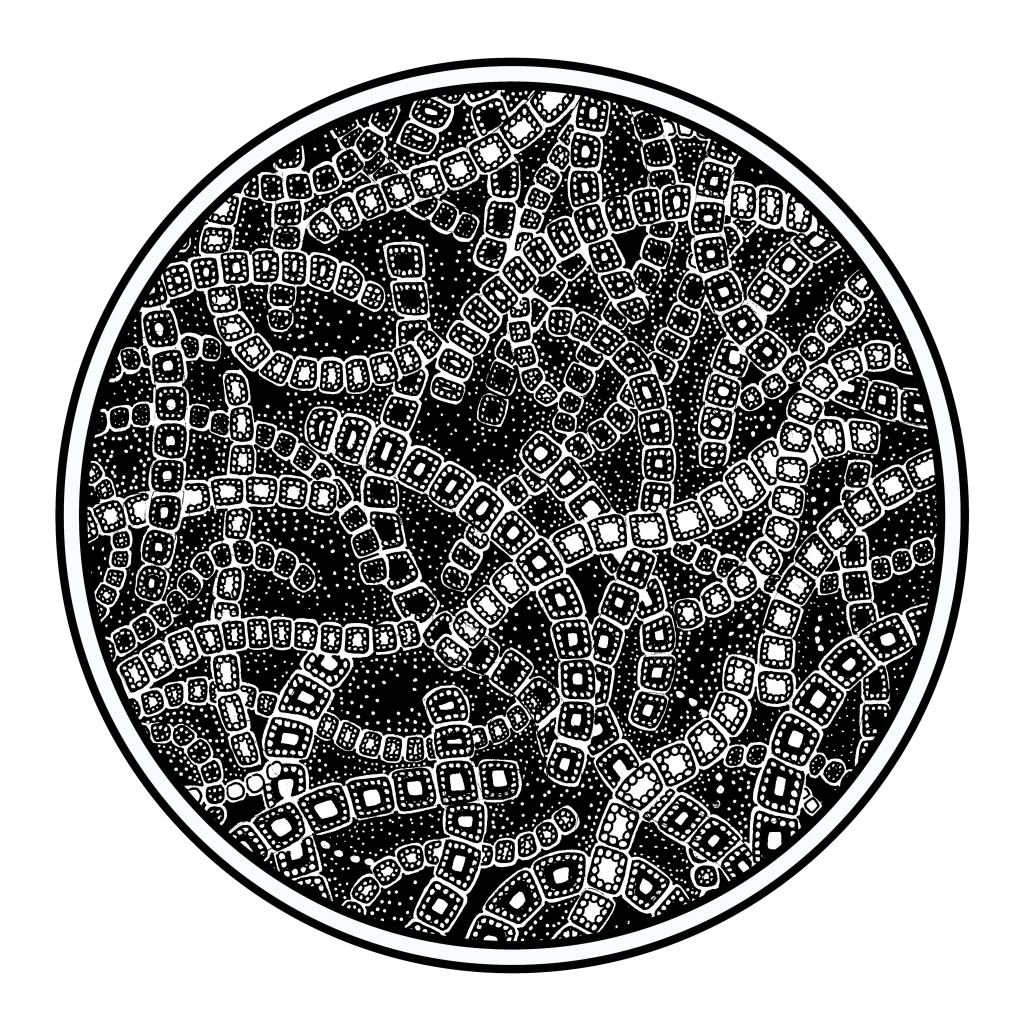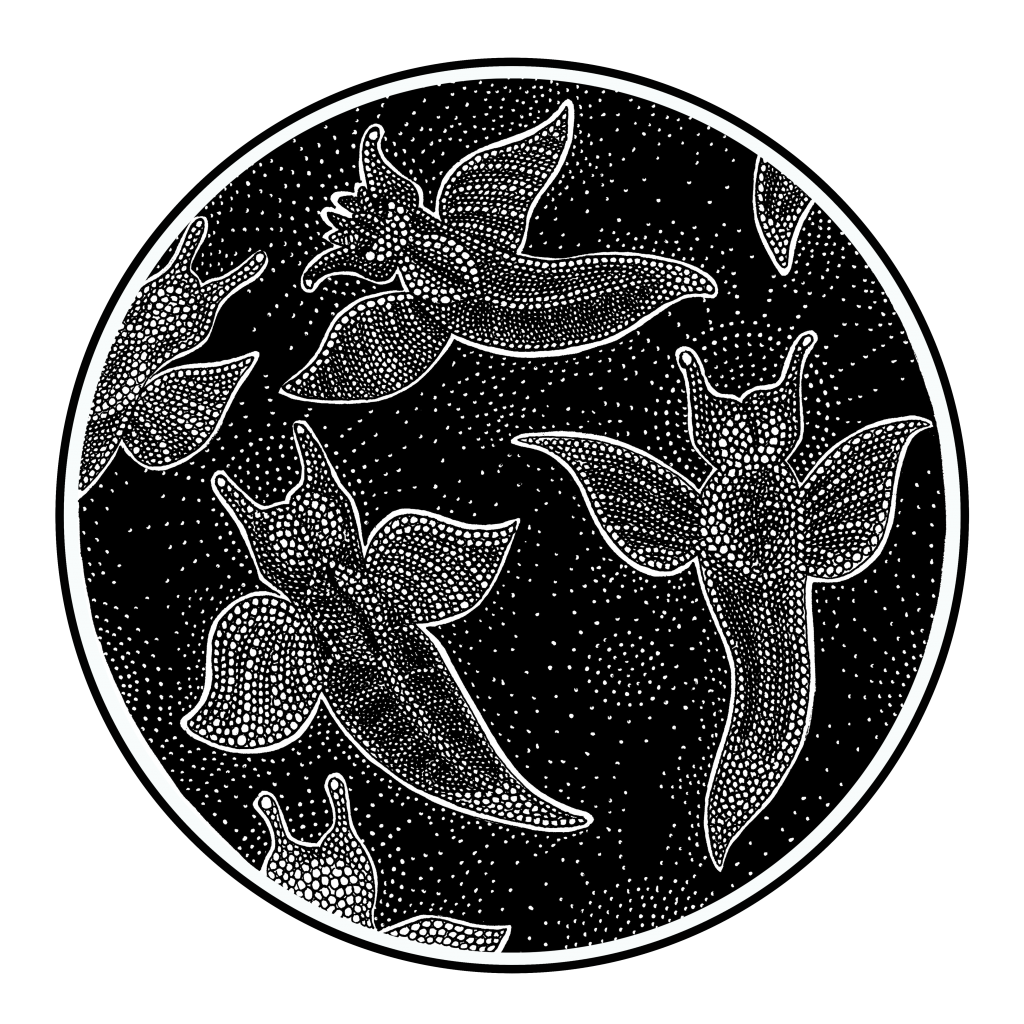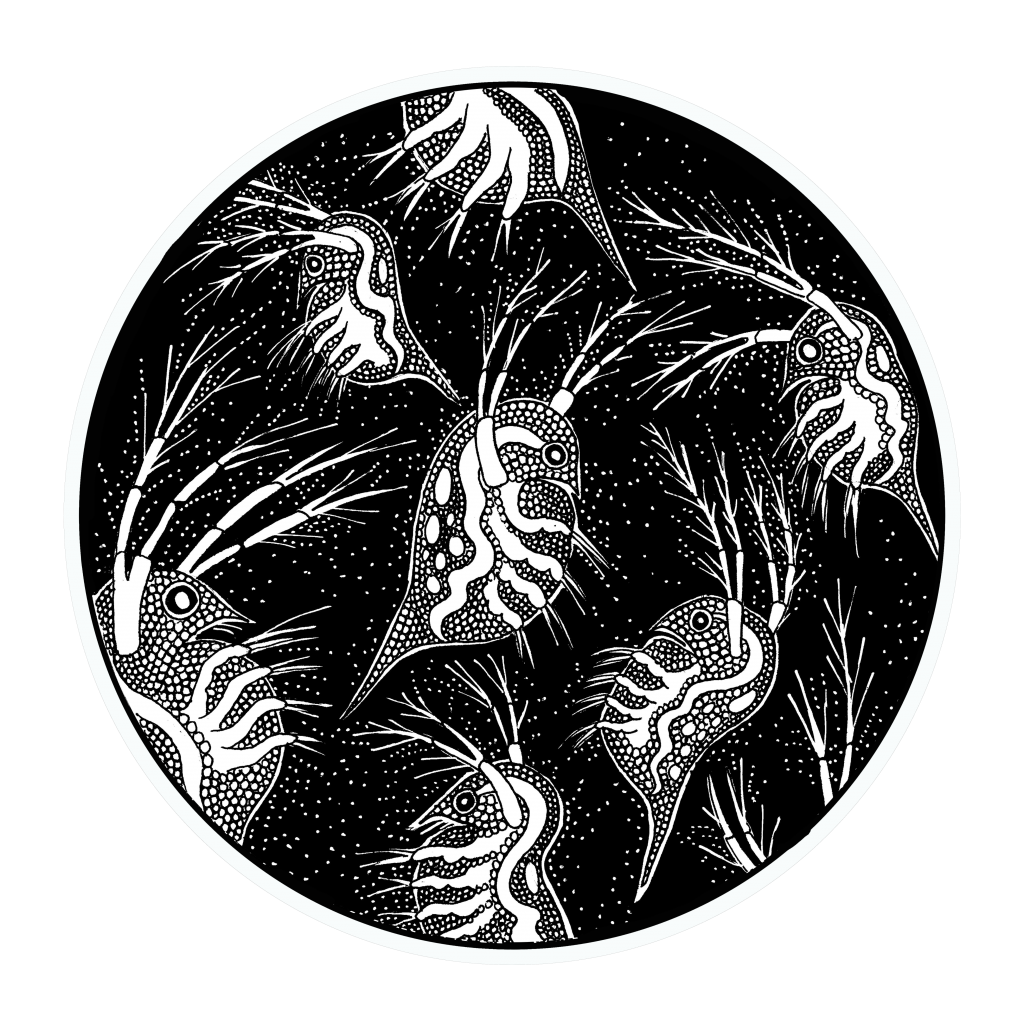
Cyanobacteria known commonly as “blue-green algae” is a unicellular prokaryotic assemblage of species that changed the world. They are the OGs of photosynthesis being thought to have arisen about 3.5 billion years ago in the prehistory of prehistory of the earth. They made their name for being the main actors in the so-called “Great Oxidation Event” or the “Rusting of the earth” which in the very early times dramatically increased the oxygen content of the atmosphere and fundamentally changed the carbon and nitrogen cycles, leading to the untimely demise of the reign of the anaerobic species populating the earth at that timeand the rise of the origins of life-forms as we know them. Today their diverse array of species is found in almost all water bodies, from temporarily moist lichen, hot springs to oceanic currents.
Diatoms are algae living in beautiful houses of glass. Their tiny unicellular bodies are surrounded by a hard structure made from silica which give them the delicate filigrane texture of their shells, or frustules. With about as many species as forms, they are extremely diverse in shape and size; with the main shapes are classed as either radially symmetrical (circular) or bilaterally symmetrical (pennate).
They found in basically any water containing surface, however, the majority live in the upper mixed layer of the oceans where they constitute nearly half of the organic material contained in the ocean at any given time. They are of great consequence to the constitution of the atmosphere as they generate 10 – 50 % of the oxygen produced on earth each year as the vast majority of diatoms are photosynthetic primary producers.


Dinoflagellates (literally meaning “whirling whip”) are single celled eukaryotes, and typically have two flagella (whiplike tails) the beating of which can drive forward movement (by the posterior typical flagella) and turning motions (by the transverse flagella). While greatly subordinate to diatoms in terms of numbers of species, dinoflagellates are one of the most ecologically significant marine eukaryote phyla.
Dinoflagellates are greatly diverse in their life history, as about half of dinoflagellates are autotrophs (like plants, creating energy from sunlight) and half are heterotrophs (like animals, obtaining energy by eating other organisms), while a number are in between, called ‘mixotrophs’ meaning that they are both capable of photosynthesis and consumption of other organisms.
Both as the base of the marine food chain as well as through their propensity to “bloom” and cause red tides, they are a force to reckoned with.
One of the most famous dinoflagellates is a little diamond called Noctiluca, literally meaning the night-light. Blooms of this species are famous for the spectacular glow of bioluminescence that they produce as a result of mechanical stress. While there are different enzymes emitting light in different dinoflagellates, one of the most common ones and the one responsible for the glow in noctiluca is an enzyme called luciferase. Interestingly, the colour of the glow in Noctiluca is different between the regions in which it occurs – generally a blue-green form will occur in colder, temperate regions while a red-orangey glow will occur in more tropical regions. Glowing in a dark sea might not seem like the best defense strategy for these poor fellows at the bottom of the food chain. However, the evolutionary reasons for this glow and modern mechanism are thought to effectively function similar to a burglar alarm. Thus, if a dinoflagellate is touched or about to be consumed by a predator their glow can act to attract predators of the predators thus reducing the chance of the predator sticking around for too long.


Today’s plankton is another Dinoflagellate and probably one of the most infamous genera: Alexandrium. A “boom’ in their populations can cause discoloration of a water body, as well as bioaccumulation of toxins, eutrophia and/or oxygen paucity. Their life history is complex with forms including single celled units, chains in lengths between 2 and 80 individuals and sexually produced cysts.
The prime toxin employed by Alexandrium, is saxitoxin, a potent neurotoxin that leads to paralysis. The main mechanism in which it is harmful to human is through shellfish poisoning – shellfish, such as mussels and oysters filter enormous quantities of water to obtain nutrients and can so build up a high concentration of whatever toxins their nutrients (in this case Alexandrium) carry. Without intervention, human consumption of affected shellfish can be deathly due to respiratory arrest. Interestingly saxitoxin was believed to be a good fit for a biological weapon and was developed for both covert and overt use by the US military before the official ban of biological warfare in the 1960s. To what extent the military, the CIA and other countries have indeed refrained from further investigating this weapon of mass destruction no one knows.
As we move from the Phytoplankton (plant like) to the zooplankton (animals like) organisms this is one that is surprisingly already classed as the latter. These beautiful unicellular protozoans were made famous by Haeckel’s early exploration of these organisms found in the sand of the Mediterranean sea.
Most are heterotrophic predators that catch and consume prey by extending parts of their body through the holes in their shell, but many species have also been found to host photosynthesizing symbionts. Their translucent cages made of silica assume incredibly diverse and unique forms, particular to the different species.
Their jump into the limelight in the mid 19th century through the scope of Haeckel’s microscope shortly followed the discovery of the cell as the smallest unit of life. This new study of the minute detail of living forms presented a huge change in our perception of the world and our place in it.


These tiny crustaceans, or “insects of the sea”, typically range between 1 and 2 mm size and are omnipresent in the water column of the ocean and of freshwater bodies. They are thought to be the most abundant group of multicellular animals on the planet. Characterised by their antennae of varying lengths and rounded and elongated bodies, many people might recognise them from their portrayal as Sheldon J. Plankton in the Spongebob franchise, as they invade even the biomes of pop culture.
Given their size, they are a major consumer of phytoplankton, and thus are responsible for “sinking” a huge amount of carbon yearly. As the phytoplankton takes up carbon directly as part of their photosynthesis, the copepods consume the phytoplankton at the surface of the ocean, generally over summer, and then take this carbon with them as they migrate into deeper waters over winter. It is thought that through this process, copepods transport 1 to 3 million tons of carbon into the deep ocean every year, from where it is unlikely to emerge for many hundreds of years. This is an area of the carbon cycle that is currently being studied as the effect of these copepod migrations on the buffering capacity of the ocean are still not fully understood.
The Antarctic krill is one of the keystone species of the Antarctic ecosystem, and one of the most abundant crustaceans, and even animals, on earth. It performs a function in linking the primary producers of the oceanic foodwebs, phytoplankton, including the tiny diatoms, to larger creatures, including fish, seabirds, and whales.
While the Antarctic krill is not classed as endangered there are indications that the stock has dropped by around 80 % since the 1970’s, and given this creatures incredible importance in the web of the cold southern oceans, they are worth paying attention to. The krill fishery that boomed in the 80s and 90s to sell krill for direct human consumption or fish bait, animal feed or cosmetic products. Global warming has driven a decrease in the Antarctics “pack ice” which is a crucial structure, particularly in the early stages of a krill’s life for protection from predators and feeding opportunities.
Apart from their ecosystem function they are thought to be one of the most important organisms in the biogeochemical carbon cycle as their diurnal vertical migrations of 100 m and their position in the food web means that they are critical in taking carbon in the form of phytoplankton from the surface to the depths of the oceans.


Echinodermata is an invertebrate phylum consisting of the starfish, sea urchins, sea cucumbers, brittle stars and crinoids. Although these are quite benthic in their adult form, like many other marine invertebrates, their larvae are planktonic to facilitate dispersal.
Echinoderms are famous for being one of the more developed radially symmetrical groups of animals. However, this feature is not apparent in their very bilaterally symmetrical larvae bodies. To get from one state if affairs to the other the larvae often develop internal disks from their germ line that, in some bizarre kind of pregnancy, will grow into the rudiments or early adult form with a while bunch of new organs. This new form will then discard and sometimes consume the old larval body. The incredible ability for regeneration in adult and larval echonoderm and their evolutionary proximity to us has made them one of the prime subjects for research into genetics, cell division and regeneration and evolutionary development.
Phyllosoma is the name of the planktonic stage of the spiny, coral and slipper lobsters. With its flat, transparent and eerie body it is a common and easily detectible sight in plankton samples. However, despite this and the commercial importance of the fisheries of their adult forms to many countries, we are only recently starting to distinguish between the Phyllosoma of different species and to understand their modes of feeding, their preferred prey and other important biological aspects.
The planktonic stage of these lobsters is unusually long – lasting anywhere between 2 to 24 months depending on the species, which can mean that these animals travel far and long before settling, a feature that has great implications for the recruitment analysis of fisheries of these lobsters. The importance and longevity of the Phyllosoma stage, the lack of comprehensive knowledge of their feeding habits and the slow growth to mature adults has significantly slowed down the attempts to culture spiny, coral or slipper lobsters.


Thecosomata or Sea Butterflies are like creatures from a fairytale – defying our earthly concept of a snail, these animals, like a psychedelic poseidonesque dream, have morphed their foot into two beautiful wings and dwindled the substance of their transparent shell down to the bare minimum. Like little aquatic fairies they flutter through the ocean, ensnaring their microscopic algal prey in a mucous net that they drag around with them. Like many other planktonic creatures they complete long daily vertical migrations – coming up to the surface overnight to feed and descending to greater depths again as the sun rises.
The thinness and calcareous constitution of their shells make these animals extremely vulnerable to ocean acidification, a type of canary in the coalmine of the ocean. In addition to the prophetic adverse effects of a sinking PH on their distribution and biology, their important role of the planktonic foodweb means that if they go, they ll take many with them.
Gymnosomata meaning “naked body” is a very apt and not very subtle Greek descriptor for this slug of the seven seas. This group has lost the external shell common to most gastropods and the foot has morphed into two wing-like appendages, which in addition to their translucent ethereal bodies have given them their celestially connotated common name. Slightly disturbingly these animals have a verocious appetite for their sister group, the sea butterflies presented in the last drawing,presented yesterday (the sea butterflies) which they actively prey on. These Hell’s Angels are twice as fast as their unfortunate prey, roaring through the seas at about 100 milimetres per second and once the chase has come to a close their soft, gelatinous body are equipped with murderous mouth appendages used to pull the unfortunate pteropod out of their shell before being grated by their file-like radula (tongue) and slurped up.


Tomopteris is a genus of polychaete (or segmented) marine worms that spends its life in the open ocean. Like many other animals in the twilight zone, they are bioluminescent. However, while the overwhelming majority of animals in those parts of the ocean emit a blue-green coloured light, which has been shown to travel most effectively through the water column, however tomopteris species have nbeen noted to use a much more rare yellow light. The enzyme itself is poorly understood, as is the reason why they decided to divert from the common trend. The most likely hypothesis is that they use for intra-species communication, kind of like a secrete language, that is often even unperceivable by other organisms whose eyes are solely trained for the more common light waves. This has been evidenced in tomopteris studies that observed that they respond more quickly and strongly to their own yellow light than to the blue-green light of other species.
A large number of cladocerans inhabit freshwater and inland water bodies, although a number of marine species are known. They are cosmopolitan in that they have been found in incredibly diverse moisture holding habitats – from the Antarctic ice sheets and underground caves to the moisture in the lichen growing on Peru’s cloud forests. They exhibit similar reproductive strategies as some aphids and rotifers in that a majority of species reproduce via cyclical parthenogenesis (asexual cloning), interspersed by some sexual reproduction. This system, estimated to go back as far as the Permian period, is thought to benefit the population growth under diverse environmental conditions – when conditions are favourable asexual reproduction allows a quick and simple increase in numbers, while sexual reproduction and gene diversification increases the groups resilience to conditions that are challenging and rapidly changing.
They are very useful to ecologists, as they are one of the main “Ecotoxicity” test organisms used to test for pollution in the environment due to the fact that they are highly sensitive to toxic substances, have short generation times, multiplies very rapidly, easily acclimatize in laboratory condition, can be cultured in a small space and can be measured in a relatively short period.


Made famous by the “Sargasso Sea” (a region in the Atlantic ocean called after this algae), this is sadly the only macroplanktonic algae that I managed to include in this series. The sargasso sea, recognised by early seafarers as a very treacherous passage due to the mass of algae tangling trapping ships is the only “sea” that has no land boundary but whose sides are instead defined by four currents: the gulf stream, the north Atlantic current, the canary current and in the south, the north Atlantic equatorial current. Only two species of sargassum are truly and fully planktonic: Sargassum natans and Sargassum fluitans. When they are not busy ensnaring unsuspecting seafarers, as planktonic macroalgae they fulfill a very special niche and create a transient structural habitat in the open ocean that allows many other pelagic species to rest, feed and shelter. While other sargassum species can generally reproduce both sexually and asexually, the pelagic species tend to be only asexual reproducers, which they do by simple fragmentation.
